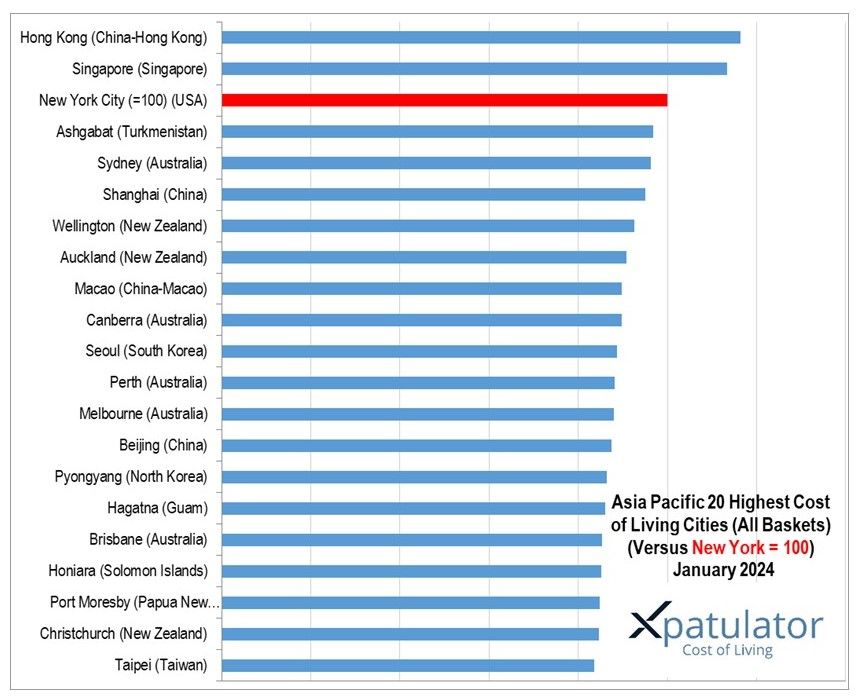
Navigating the Cost of Living in Asia Pacific 2024
2024-01-01
In the ever-shifting landscape of global economies, the latest Worldwide Cost of Living survey conducted by Xpatulator in January 2024 has cast a revealing light on the challenges faced by Asia-Pacific cities. As the region grapples with the aftermath of the pandemic, a myriad of factors continues to contribute to the relatively high cost of living for expatriates, particularly in areas with limited space, currency appreciation against the US Dollar, and demand constraints. Despite some respite from the peak of inflation, economists caution that formidable challenges persist, with the spectre of inflation risks looming large on the horizon.
Hong Kong retains its status as the most expensive location in Asia Pacific for expatriates in 2024, boasting a Cost of Living Index (COLI) of 116. The primary driver behind this financial distinction is the exorbitant housing costs resulting from the city's perennial struggle with limited space. As the towering skyscrapers dominate the cityscape, the real estate market in Hong Kong remains fiercely competitive, propelling it to the apex of the cost-of-living hierarchy.
 Securing the second position with a COLI of 113, Singapore stands as a testament to the intricate interplay of economic factors influencing living costs. The city-state's renowned education system, coupled with high housing costs and an intricate Certificate of Entitlement system driving up car prices, positions Singapore among the top contenders for the most expensive locations for expatriates. It is a delicate balancing act between quality education and the financial implications of constrained resources.
Securing the second position with a COLI of 113, Singapore stands as a testament to the intricate interplay of economic factors influencing living costs. The city-state's renowned education system, coupled with high housing costs and an intricate Certificate of Entitlement system driving up car prices, positions Singapore among the top contenders for the most expensive locations for expatriates. It is a delicate balancing act between quality education and the financial implications of constrained resources.
Taking the third spot behind Hong Kong and Singapore is Ashgabat in Turkmenistan. Economic challenges faced by the Turkmenistan government manifest in economic and currency issues, significantly impacting the cost of goods and services for expatriates in Ashgabat. As the city grapples with its unique economic odyssey, it underscores the broader economic challenges faced by nations in the Asia-Pacific region.
The biggest movers up the cost-of-living rankings in Asia-Pacific in the past quarter are cities in Australia and New Zealand. This surge is attributed to relatively high minimum wages, substantial taxation rates, and high demand for housing and resources. Stubbornly high inflation and rising interest rates have further intensified the pressure on expatriate budgets, making these locations increasingly expensive for foreign residents.
Conversely, the biggest movers down the cost-of-living rankings in the region are cities in Nauru, Uzbekistan, and Japan. Japan stands out as a potential haven for expatriates seeking affordability. With almost no inflation in the last decade and the recent depreciation of the yen, Japan's attractiveness has soared, positioning it as a potentially budget-friendly destination in the developed world.
As we navigate the complex landscape of global living costs, these shifts underscore the intricate interplay of economic factors, currency fluctuations, and local dynamics shaping the international cost of living at the close of 2023. As the world looks toward 2024, the spectre of persistent inflation looms large, presenting challenges for nations striving to strike a balance between economic growth and the well-being of their residents. The cost of living in Asia-Pacific is a dynamic tapestry, weaving together the economic nuances of each region into a complex yet revealing narrative.